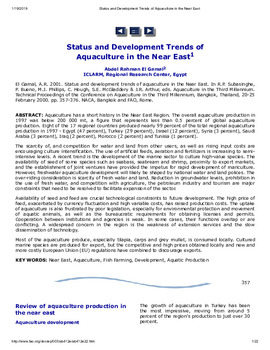Status and development trends of aquaculture in the near east

Citation
El Gamal, A.R. (2001). Status and development trends of aquaculture in the near east. In: NACA/FAO, 2001. Aquaculture in the Third Millennium. Subasinghe, R.P., Bueno, P., Phillips, M.J., Hough, C., McGladdery, S.E., & Arthur, J.E. (Eds.) Technical Proceedings of the Conference on Aquaculture in the Third Millennium, Bangkok, Thailand. 20-25 February 2000. NACA, Bangkok and FAO, Rome.
Aquaculture has a short history in the Near East Region. The overall aquaculture production in 1997 was below 200 000 mt, a figure that represents less than 0.5 percent of global aquaculture production. Eight of the 17 regional countries produced nearly 99 percent of the total regional aquaculture production in 1997 - Egypt (47 percent), Turkey (29 percent), Israel (12 percent), Syria (3 percent), Saudi Arabia (3 percent), Iraq (2 percent), Morocco (2 percent) and Tunisia (1 percent). The scarcity of, and competition for water and land from other users, as well as rising input costs are encouraging culture intensification. The use of artificial feeds, aeration and fertilizers is increasing to semi-intensive levels. A recent trend is the development of the marine sector to culture high-value species. The availability of seed of some species such as seabass, seabream and shrimp, proximity to export markets, and the establishment of joint ventures have provided the impetus for rapid development of mariculture. However, freshwater aquaculture development will likely be shaped by national water and land polices. The over-riding consideration is scarcity of fresh water and land. Reduction in groundwater levels, prohibition in the use of fresh water, and competition with agriculture, the petroleum industry and tourism are major constraints that need to be resolved to facilitate expansion of the sector. Availability of seed and feed are crucial technological constraints to future development. The high price of feed, exacerbated by currency fluctuation and high variable costs, has raised production costs. The uptake of aquaculture is also frustrated by poor legislation, especially for environmental protection and movement of aquatic animals, as well as the bureaucratic requirements for obtaining licenses and permits. Cooperation between institutions and agencies is weak. In some cases, their functions overlap or are conflicting. A widespread concern in the region is the weakness of extension services and the slow dissemination of technology. Most of the aquaculture produce, especially tilapia, carps and grey mullet, is consumed locally. Cultured marine species are produced for export, but the competitive and high prices obtained locally and new and more costly European Union (EU) regulations have combined to discourage exports.
Permalink
Date Available
Type
Countries
Research Themes
Topics
Language